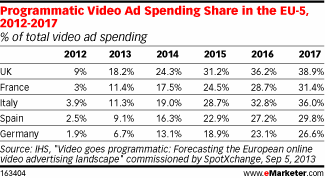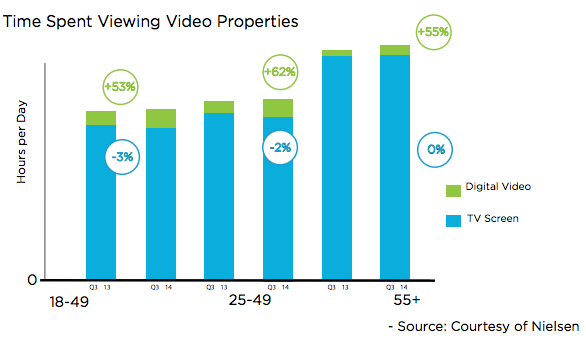The Prospects for Programmatic Video in France
by on 22nd Apr 2015 in News


Video is tipped to buoy the value of the overall programmatic media-buying market in France in the years to come, as media owners embrace the technology, with ad tech vendors also hoping their wares will tap into lucrative TV budgets. Ahead of ATS Paris 2015, ExchangeWire explores the prospects, including if the market is a more dynamic one than the UK?
Competition in the French programmatic video advertising space is rife, making it one of the most buoyant sectors in Europe, with many market sources claiming it surpasses that of the UK – widely assumed to be the leading European ad tech market.
An earlier eMarketer study – commissioned by SpotXchange – ranks France as the third-largest video advertising market across Europe (see table, right).
However, the same report also finds that although France and Germany will show nearly identical patterns of sales growth, at present they have very different contexts for online video advertising.
Subsequently, IHS researchers found that proactive French media owners were receptive to employing ad tech, and forming alliances that encouraged programmatic ad buying in “a controlled environment.”
ATS Paris keynote presenter Emmanuel Crego, One by AOL, Video, recently explained to ExchangeWire readers this was the result of publishers there eager to adopt new technologies in a bid to reconcile the historic power dynamic between themselves and advertisers. Plus, the latter are eager to embrace the efficiencies of programmatic trading.
"As well as better returns, marketers are able to simplify their buying process. Instead of managing dozens of technology systems, they can now consolidate this activity into a few core systems," he said.
Programmatic video attracting brand spend
 Nick Reid, TubeMogul, managing director, and ATS Paris panellist, (pictured left) also claims there is much greater "fluidity" in the French market (compared to the UK) when it comes to programmatic video supply, given that there are fewer supply constraints there.
Nick Reid, TubeMogul, managing director, and ATS Paris panellist, (pictured left) also claims there is much greater "fluidity" in the French market (compared to the UK) when it comes to programmatic video supply, given that there are fewer supply constraints there.
Indeed, so positive is TubeMogul regarding the prospects of the French automated video-buying market, that it has recently appoint its first commercial director, with François Xavier Le Ray taking the role at the start of this year.
TubeMogul's Reid went on to tell ExchangeWire: "The video-on-demand (VoD) market is much greater in France via the [set-top] boxes, which are provided by companies such as Orange [along with rivals such as Bouyuges and SFR, who can also provide IPTV services]."
 In fact, earlier this year, TF1 Publicité – a national broadcaster that is 43%-controlled by Buoyuges – launched an ad exchange to auction off video inventory via real-time auctions (RTB) on its catch-up TV service MYTF1, according to a report penned by Anne-Sophie Lizzani, OffreMedia journalist, 100% MATIC, and ATS Paris panellist (pictured, right).
In fact, earlier this year, TF1 Publicité – a national broadcaster that is 43%-controlled by Buoyuges – launched an ad exchange to auction off video inventory via real-time auctions (RTB) on its catch-up TV service MYTF1, according to a report penned by Anne-Sophie Lizzani, OffreMedia journalist, 100% MATIC, and ATS Paris panellist (pictured, right).
Lizzani's article goes on to state how Coca-Cola was the first advertiser to deploy an RTB campaign within the MYTF1 IPTV content via Publicis Groupe media agency Starcom MediaVest using the holding group's AOD trading desk, with the platform developed by sell-side platform (SSP) StickyADS.tv (a fellow French native).
In a more recent blog post, Sylvain Deffay, Infectious Media, country manager, France, explained how such developments in the French market – as well as StickyAds Video Exchange’s recent integration with TubeMogul’s demand-side platform (DSP) – were a: "very positive development for the French RTB market", and would open up programmatic video to lucrative brand spend.
A step away from programmatic RTB?
TubeMogul's Reid sees exchanges such as IPTV One Exchange as "the first iteration of programmatic TV ad buying" (a prospect his company is actively promoting in the UK). TubeMogul's white paper also discusses some of the intransigence from parties involved in the TV advertising business who are hesitant to depart from the current de facto models of trading TV inventory. Namely, these include broadcasters harbouring fears that such a move will lead to the commoditisation of their TV inventory.
However, for Reid, the predominant model of selling ad opportunities on set-top boxes using such technologies will be 'programmatic reserved' – where media purchasing decisions are automated through the use of data, as opposed to RTB – and that broadcasters elsewhere would do well to learn from the "entrepreneurialism" of the programmatic video sector in France.
"I don't realistically see programmatic TV [monetisation] being auction-based," he adds.
Programmatic TV? Connecting the dots...
 Fellow ATS Paris panellist Randy Cooke, SpotXchange, VP of programmatic TV, believes broadcasters must find ways to cross-screen advertising opportunities via a centralised platform that can manage and package TV and online video opportunities to advertisers; just as publishers have learned to package digital and print.
Fellow ATS Paris panellist Randy Cooke, SpotXchange, VP of programmatic TV, believes broadcasters must find ways to cross-screen advertising opportunities via a centralised platform that can manage and package TV and online video opportunities to advertisers; just as publishers have learned to package digital and print.
In a recently published white paper discussing the opportunity, he adds: “Content owners will have to become adept in ‘horizontal yield management’ – managing rate and audience fulfillment across channels and viewing streams, rather than as individualised buckets of siloed impressions.”
With properly configured systems, it’s possible to centrally manage ad revenue, add layers of contextual relevance and measure engagement and attribution from a single platform, according to SpotXchange.
"Siloed agency buying disciplines, disparate transactional practices and differences in how inventory is defined between the digital and linear worlds have slowed the convergence of video into a singular marketplace," reads SpotXchange’s analysis.
Cooke adds: “Convergence of video is inevitable but cannot occur until the industry has collectively resolved a litany of issues related to currency, viewability and transactional transparency.”
Local market sources tell ExchangeWire that anywhere between 30-40% of the addressable French TV-households view programming via the set-top boxes described earlier by Reid (due in large part to many companies such as Bouyuges, Orange and SFR offering internet, telephony, and TV services via single subscriptions).
Add this with developments such as TF1 Publicitié's IPTV One Exchange, plus innovations from fellow French market players such as Sticky.ADS.tv, and the enthusiasm from the sell-side is clear.
View from the buy-side?
However, with such eagerness from the French sell-side to progress towards programmatic TV-buying (across all screens) what is the view of the advertiser? This will be the subject of one of the standout ATS Paris panels featuring several prominent figures including Publicis Groupe's Vivaki, and confectionary giant Mars.
The panels explores whether the adoption of Nielsen OCR data into France’s video advertising market will further its position as the foremast market for programmatic video.
The SpotXchange white paper (SpotXchange's Cooke will participate on this panel) contains Nielsen figures indicating that, although video consumption is increasing, it is increasingly taking place across separate screens, with the emergence of mobile devices further exacerbating this fragmentation (see chart below).
The report reads: "Convergence of video is inevitable, but from an ad sales perspective cannot occur until the industry has collectively resolved a litany of pressing issues related to currency, viewability and transactional transparency.
"Siloed agency buying disciplines, disparate transactional practices, and even the differences in how inventory is defined between the digital and linear worlds have served to slow the convergence of video into a singular marketplace. All of these challenges lead to media owners leaving money on the table."
 Adeline Quéroix-Gabay, Vivaki, head of Audience On Demand, a fellow participant on the panel, (pictured, right) spoke with ExchangeWire about a shift towards channeling TV ad budgets into online video, as well as the prospect of programmatic TV.
Adeline Quéroix-Gabay, Vivaki, head of Audience On Demand, a fellow participant on the panel, (pictured, right) spoke with ExchangeWire about a shift towards channeling TV ad budgets into online video, as well as the prospect of programmatic TV.
EW: Will the adoption of Nielsen OCR data – the long-held metric used to assess the effectiveness of TV advertising – help draw some of the lucrative advertising budgets from TV there, and increase programmatic video spend?
AQG: While some traditional brand advertisers are still questioning the effectiveness of online video, including the way it is measured, there are others who have adopted Video Neutral Planning (VPN) strategies aimed at maximising video targeted contacts, irrespective of device (TV, desktop, and now tablets/smartphones).
This is where programmatic video becomes interesting as the conversation moves to greater efficiency and targeting and more control over frequency-capping across publishers. On a large scale, online video (programmatic or not) is still not considered as a credible alternative to TV.
Some brands allocate digital budget for online video. Others take from TV budgets (video neutral planning strategies). The same hesitation exists within media agencies. Online video is bought either by digital buyers or TV media buyers, depending on organisations and/or the objectives assigned for online video (awareness/direct response and engagement).
EW: You mentioned some advertisers adopting a VPN approach to target audiences across screens, where are French advertisers in terms of finding a measurement strategy of this approach?
AQG: We are still missing a credible scalable measurement of video-neutral planning strategies. OCR is supposed to be the one, but it is not yet adopted among French advertisers, and I’m not sure it will be.
Firstly, it is expensive. Advertisers have to pay for it when Mediamat (TV panel) is at no extra cost and is supported by media agencies and TV broadcasters.
Secondly, it is not really actionable. Of course you have D+1 data performances, but you can’t buy OCR data, and the demo data available in the market is usually not consistent. The highest Mediametrie benchmarks top at 58%. The only publisher on the market that has data with a very high score is Facebook, who will likely build a closed ecosystem around it.
Thirdly, is it really worth going back to old school media targeting when you can target based on your own data sets and based on consumption habits?
EW: What other issues are there around the adoption of programmatic video?
AQG: There is significant work to do around the impact of video (viewability, completion, effectiveness on awareness, and offline sales) before looking at targeting verification. We also need to solve cross-device tracking when most of catch-up TV is watched on the TV screen and tablet audiences are growing.
Finally, the main issue to win TV budgets is the price of in-stream. Online video becomes competitive on certain target audiences only when TV has saturated reach, not on all the audience. OCR is probably a minor improvement compared to this. Perhaps when TV finally becomes addressable, we can expect to digitise media audiences based on behavioural instead of simple demographic targeting, but that is still likely a long way off for marketers.
AdvertiserAgencyAnalyticsATSAutomated GuaranteedCreativeCross-ChannelDigital MarketingDSPEMEAIndustry InfrastructureMedia SpendMobileProgrammaticPublisherTargetingTradingTrading DeskTVVideoViewability










Follow ExchangeWire